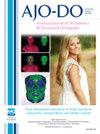使用矫治器进行有计划的臼齿嵌入是否有助于前方开放性咬合的闭合?
IF 2.7
2区 医学
Q1 DENTISTRY, ORAL SURGERY & MEDICINE
American Journal of Orthodontics and Dentofacial Orthopedics
Pub Date : 2024-10-01
DOI:10.1016/j.ajodo.2024.04.016
引用次数: 0
摘要
简介:本研究旨在确定在使用隐适美透明矫治器(Align Technology, Santa Clara, Calif)治疗的成年患者中,有无虚拟咬合阻滞(BB)的情况下,规定的臼齿内嵌是否会导致实际的臼齿内嵌,并有助于前开放性咬合(AOB)的矫正:方法:对 36 名患有前开放性咬合的成年患者进行了一项回顾性研究。受试者被分为两个治疗组:计划臼齿内侵(PMI)组和无计划臼齿内侵(No-PMI)组。PMI是从ClinCheck软件的牙齿移动表中获得的。PMI 患者根据是否存在虚拟后 BB 进一步分类(分别为 PMI-BB 和 PMI-No BB)。治疗成功与否的判断依据是治疗后头相图中垂直切牙重叠是否为阳性。治疗变化通过治疗前和治疗后的头颅X光片进行评估(Welch 2样本t检验,95%置信区间,P = 0.05)。最后,使用照相开放性咬合严重程度指数(POSI)评估治疗后至少一年的治疗稳定性:结果:15 名患者无PMI,21 名患者无PMI(共36 人)。无PMI患者的平均咬合过度变化为2.5 ± 1.0毫米,PMI患者的平均咬合过度变化为3.2 ± 1.8毫米(P = 0.12)。所有患者在治疗后的头影照片中都有垂直切牙重叠,表明治疗成功率为 100%。在两个治疗组中,开合咬合主要通过切牙后倾和挤压得到矫正。PMI组的臼齿内陷平均测量值比无PMI组的变化值大0.71毫米,但在控制了潜在的混杂变量后,差异无统计学意义(P = 0.074)。使用 POSI 分析法对原始样本中的 14 名患者进行了稳定性评估。其中 12 人(85.7%)的 POSI 得分为 0.结论:无论臼齿侵入是否在计划之内,隐适美透明矫治器矫正AOB的方式主要是切牙挤压和后倾。总的来说,矫治器是治疗成人AOB的有效矫治器。根据我们有限的样本,治疗的稳定性与固定矫治器的报告相似。本文章由计算机程序翻译,如有差异,请以英文原文为准。
Does planned molar intrusion with aligners assist with closure of anterior open bite?
Introduction
This study aimed to determine whether prescribed molar intrusion, with or without virtual occlusal bite-blocks (BB), resulted in actual molar intrusion and assisted with anterior open bite (AOB) correction in adult patients treated with Invisalign clear aligners (Align Technology, Santa Clara, Calif).
Methods
A retrospective study was conducted with 36 adult patients with AOB. Subjects were divided into 2 treatment groups: planned molar intrusion (PMI) and no-PMI (No-PMI). PMI was obtained from the tooth movement tables in the ClinCheck software. Patients with PMI were further categorized by the presence or absence of virtual posterior BB (PMI-BB and PMI-No BB, respectively). Treatment success was determined on the basis of positive vertical incisor overlap in posttreatment cephalograms. Treatment changes were assessed using pretreatment and posttreatment cephalometric radiographs (Welch 2-sample t test, 95% confidence interval, P = 0.05). Finally, treatment stability was assessed at least 1-year posttreatment using the Photographic Open Bite Severity Index (POSI).
Results
There were 15 patients with No-PMI and 21 without PMI (total n = 36). The mean overbite change was 2.5 ± 1.0 mm for No-PMI and 3.2 ± 1.8 mm for patients with PMI (P = 0.12). All patients had positive vertical incisor overlap in posttreatment cephalograms, indicating 100% treatment success. Open bites were corrected primarily by incisor retroclination and extrusion in both treatment groups. The average measured molar intrusion for the PMI group was 0.71 mm greater than the change for the No-PMI group, but the difference was not statistically significant after controlling for potentially confounding variables (P = 0.074). A total of 14 patients from the original sample were assessed for stability using the POSI analysis. Of those, 12 (85.7%) had a POSI score of 0.
Conclusions
Regardless of whether the molar intrusion was planned or not, the modality of AOB correction with Invisalign clear aligners was primarily incisor extrusion and retroclination. Overall, aligners are an effective appliance for the treatment of adult AOB. Based on our limited sample, treatment stability was similar to that reported for fixed appliances.
求助全文
通过发布文献求助,成功后即可免费获取论文全文。
去求助
来源期刊
CiteScore
4.80
自引率
13.30%
发文量
432
审稿时长
66 days
期刊介绍:
Published for more than 100 years, the American Journal of Orthodontics and Dentofacial Orthopedics remains the leading orthodontic resource. It is the official publication of the American Association of Orthodontists, its constituent societies, the American Board of Orthodontics, and the College of Diplomates of the American Board of Orthodontics. Each month its readers have access to original peer-reviewed articles that examine all phases of orthodontic treatment. Illustrated throughout, the publication includes tables, color photographs, and statistical data. Coverage includes successful diagnostic procedures, imaging techniques, bracket and archwire materials, extraction and impaction concerns, orthognathic surgery, TMJ disorders, removable appliances, and adult therapy.

 求助内容:
求助内容: 应助结果提醒方式:
应助结果提醒方式:


